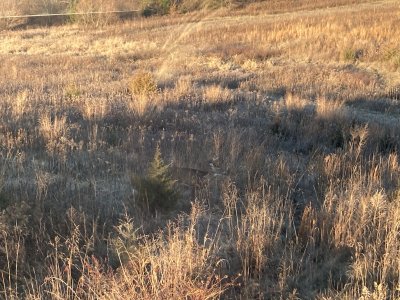Plan for the long game, nothing lasting happens quickly
Don't do any changes for a couple years, using that time to come up with a plan using the knowledge learned from those two years how the deer use your property and how the neighbors use their property. If not, a bit of rework will be happening.
On small properties, one needs to hunt perimeters if possible and let your scent blow into neighboring property. Big properties allow more intrusion but small will be blown up easily.
Screen stand access if possible
Screen roads and neighbors
Learn how to id trees before you decide to cut any down and plant what will grow in your area.
If you plant trees, protect them
Pear and apple trees if possible (learn root stock and learn to graft, you'll save lots and be able to plant more) Five to seven years and it will be paying off
One can take bare property and turn it into a wildlife mecca. It will take a couple decades but it gets huntable after the first 4 or 5 years
Try to get to know your neighbors in a positive way
Post your property and prosecute violators.
Be disciplined on taking entry and exit routes no matter how tough or crappy it may be.
Get some water holes established right away, my water holes the past two years because of drought turned into essentially corn piles, It's been amazing to see what has come to them to drink. Once they know it's there they will keep coming back. Try to put them in natural drainages if using tanks and not dugouts. An inch or two of rain will fill my 110 gallons easily where I have them placed but they are still accessible to drive up to, to refill if nature has shut off the valve.
If you cut down trees/brush you don't want coming back, treat them with triplocyr or some other herbicide, but read label, you don't want to kill the rest of the areas broad-leafed plants
Hold your cards close to your chest, what you have/see/kill on your land can be used against you by neighboring hunters. With that said, All this depends on who your neighbors are, get to know them before you blab all about the above.
The sooner you start on your projects, the sooner you'll reap the benefits. It's a lot of work but a labor of love to me. I wouldn't have it any other way
I recommend Steve Bartylla's books on habitat and hunting to give one some ideas and strategies. Like any of the "experts" in whitetail habitat developement, not all their ideas will work for everywhere, Glean from them the ideas that will work for you.
Don't do any changes for a couple years, using that time to come up with a plan using the knowledge learned from those two years how the deer use your property and how the neighbors use their property. If not, a bit of rework will be happening.
On small properties, one needs to hunt perimeters if possible and let your scent blow into neighboring property. Big properties allow more intrusion but small will be blown up easily.
Screen stand access if possible
Screen roads and neighbors
Learn how to id trees before you decide to cut any down and plant what will grow in your area.
If you plant trees, protect them
Pear and apple trees if possible (learn root stock and learn to graft, you'll save lots and be able to plant more) Five to seven years and it will be paying off
One can take bare property and turn it into a wildlife mecca. It will take a couple decades but it gets huntable after the first 4 or 5 years
Try to get to know your neighbors in a positive way
Post your property and prosecute violators.
Be disciplined on taking entry and exit routes no matter how tough or crappy it may be.
Get some water holes established right away, my water holes the past two years because of drought turned into essentially corn piles, It's been amazing to see what has come to them to drink. Once they know it's there they will keep coming back. Try to put them in natural drainages if using tanks and not dugouts. An inch or two of rain will fill my 110 gallons easily where I have them placed but they are still accessible to drive up to, to refill if nature has shut off the valve.
If you cut down trees/brush you don't want coming back, treat them with triplocyr or some other herbicide, but read label, you don't want to kill the rest of the areas broad-leafed plants
Hold your cards close to your chest, what you have/see/kill on your land can be used against you by neighboring hunters. With that said, All this depends on who your neighbors are, get to know them before you blab all about the above.
The sooner you start on your projects, the sooner you'll reap the benefits. It's a lot of work but a labor of love to me. I wouldn't have it any other way
I recommend Steve Bartylla's books on habitat and hunting to give one some ideas and strategies. Like any of the "experts" in whitetail habitat developement, not all their ideas will work for everywhere, Glean from them the ideas that will work for you.

